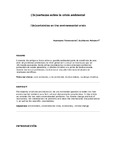
Please use this identifier to cite or link to this item:
http://ricaxcan.uaz.edu.mx/jspui/handle/20.500.11845/237Full metadata record
| DC Field | Value | Language |
|---|---|---|
| dc.contributor.other | 0000-0002-7441-3233 | |
| dc.coverage.spatial | Global | es_ES |
| dc.creator | Foladori, Guillermo | |
| dc.creator | Tommasino, Humberto | |
| dc.date.accessioned | 2017-05-16T17:40:26Z | |
| dc.date.available | 2017-05-16T17:40:26Z | |
| dc.date.issued | 2001-01 | |
| dc.identifier | info:eu-repo/semantics/publishedVersion | |
| dc.identifier.issn | 1414-753X | es_ES |
| dc.identifier.issn | 1809-4422 | es_ES |
| dc.identifier.uri | http://hdl.handle.net/20.500.11845/237 | |
| dc.description | The majority of articles and books on the environmental question consider the main environmental problems as a fact, without discussing its uncertainties. In this article we consider the two main environmental problems: the climate change and lost of biodiversity. We characterize the problems and show the international discussion about it, as well as the scientific uncertainties. | es_ES |
| dc.description.abstract | Uno de los objetivos de este artículo es mostrar que la situación ambiental contemporánea no sólo implica un alto grado de riesgo para las generaciones futuras, sino que también presenta un importante nivel de incertidumbre en cuanto a los conocimientos que se tienen de ella. Aún así, lo que parecería estar fuera de discusión es que el ser humano ha llegado a tener una presencia en la biósfera nunca antes vista y con un grado de extensión y profundidad irreversible en muchas esferas. La siguiente cita de Vitousek et.al. resume, apretadamente, esa presencia humana en la biósfera: Human alteration of Earth is substantial and growing. Between one-third and one-half of the land surface has been transformed by human action; the carbon dioxide concentration in the atmosphere has increased by nearly 30 percent since the beginning of the Industrial Revolution; more atmospheric nitrogen is fixed by humanity than by all natural terrestrial sources combined; more than half of all accessible surface fresh water is put to use by humanity; and about one-quarter of the bird species on Earth have been driven to extinction. By these and other standards, it is clear that we live on a human.dominated planet (VITOUSEK, et.al., 1997: 494). | es_ES |
| dc.language.iso | spa | es_ES |
| dc.publisher | Associação Nacional de Pós-Graduação e Pesquisa em Ambiente e Sociedade | es_ES |
| dc.relation | http://www.scielo.br/scielo.php?script=sci_arttext&pid=S1414-753X2001000800004 | es_ES |
| dc.relation.uri | generalPublic | es_ES |
| dc.rights | openAccess | es_ES |
| dc.rights.uri | http://creativecommons.org/licenses/by-nc-sa/3.0/us/ | * |
| dc.source | Ambiente & Sociedade no.8 Campinas Jan./June | es_ES |
| dc.subject.classification | TECNOLOGÍA Y CAMBIO SOCIAL [6] | es_ES |
| dc.subject.other | info:eu-repo/classification/Medio ambiente | |
| dc.subject.other | info:eu-repo/classification/Crisis ambiental | |
| dc.subject.other | info:eu-repo/classification/Cambio climatico | |
| dc.title | (In)certezas sobre la crisis ambiental | es_ES |
| dc.type | info:eu-repo/semantics/article | es_ES |
| Appears in Collections: | *Documentos Académicos*-- UA Estudios del Desarrollo | |
Files in This Item:
| File | Description | Size | Format | |
|---|---|---|---|---|
| Foladori, Guillermo. Incertezas sobre la crisis ambiental.pdf | Versión publicada | 423,51 kB | Adobe PDF |  View/Open |
This item is licensed under a Creative Commons License
